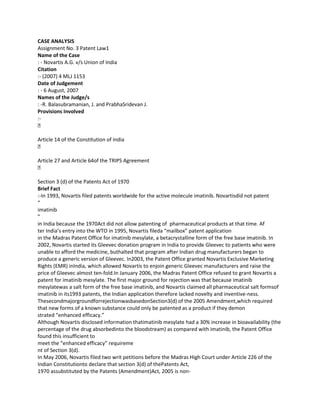
Case analysis novartis vs union of india
- 1. CASE ANALYSIS Assignment No. 3 Patent Law1 Name of the Case : - Novartis A.G. v/s Union of India Citation :- (2007) 4 MLJ 1153 Date of Judgement : - 6 August, 2007 Names of the Judge/s : -R. Balasubramanian, J. and PrabhaSridevan J. Provisions Involved :- Article 14 of the Constitution of India Article 27 and Article 64of the TRIPS Agreement Section 3 (d) of the Patents Act of 1970 Brief Fact :-In 1993, Novartis filed patents worldwide for the active molecule imatinib. Novartisdid not patent “ imatinib ” in India because the 1970Act did not allow patenting of pharmaceutical products at that time. Af ter India’s entry into the WTO in 1995, Novartis fileda “mailbox” patent application in the Madras Patent Office for imatinib mesylate, a betacrystalline form of the free base imatinib. In 2002, Novartis started its Gleevec donation program in India to provide Gleevec to patients who were unable to afford the medicine, buthalted that program after Indian drug manufacturers began to produce a generic version of Gleevec. In2003, the Patent Office granted Novartis Exclusive Marketing Rights (EMR) inIndia, which allowed Novartis to enjoin generic Gleevec manufacturers and raise the price of Gleevec almost ten-fold.In January 2006, the Madras Patent Office refused to grant Novartis a patent for imatinib mesylate. The first major ground for rejection was that because imatinib mesylatewas a salt form of the free base imatinib, and Novartis claimed all pharmaceutical salt formsof imatinib in its1993 patents, the Indian application therefore lacked novelty and inventive-ness. ThesecondmajorgroundforrejectionwasbasedonSection3(d) of the 2005 Amendment,which required that new forms of a known substance could only be patented as a product if they demon strated “enhanced efficacy.” Although Novartis disclosed information thatimatinib mesylate had a 30% increase in bioavailability (the percentage of the drug absorbedinto the bloodstream) as compared with imatinib, the Patent Office found this insufficient to meet the “enhanced efficacy” requireme nt of Section 3(d). In May 2006, Novartis filed two writ petitions before the Madras High Court under Article 226 of the Indian Constitutionto declare that section 3(d) of thePatents Act, 1970 assubstituted by the Patents (Amendment)Act, 2005 is non-
- 2. complaint with theTRIPSAgreement and / or is unconstitutional being vague, arbitrary and violative of Ar ticle 14 of the Constitution ofIndia and consequentially to direct the Controller General of Patents & Designstoallow the Patent Application. The respondents to the suit were the IndianGovernment, the Patent Office, several Indian generic drug manufacturers and an Indian public interest group. The Indian generic drug manufacturers were Natco Pharma, Cipla,Hetro Drugs, Ranbaxy, Indian Pharmaceutical Alliance and SunPharmaceuticals. The Indian public Interest group was Cancer Patient Aid Association. The case was bifurcated betweenthe Madras High Court and the Intellectual Property Appellate Board (IPAB). The challengeson TRIPS compliance and constitutionality of Section 3(d) were heard by the Madras HighCourt. Issues :- Whether courts in India have jurisdiction to review if Section 3(d) of the 2005Amendment is compliant with Article 27 of TRIPS, and alternatively, whether courtsin India can grant declaratory relief that Section 3(d) is not compliant with TRIPS andtherefore violative of Article 14 of the Constitution of India. If the courts do have jurisdiction, whether Section3(d) complies with Article 27 of TRIPS. Whether Section 3(d) violates Article 14 of the Constitution of India because it isvague, arbitrary and confers uncontrolled discretion to the Patent Controller. Arguments : - Whether courts in India have jurisdiction to review if Section 3(d) of the 2005 Amendment is compliant with Article 27 of TRIPS andalternatively, whether courts in India can grant declaratory relief that
- 4. Whether Section 3(d) violates Article 14 of the Constitution of India because it isvague, arbitrary and confers uncontrolled discretion to the Patent Controller. Arguments : - Whether courts in India have jurisdiction to review if Section 3(d) of the 2005 Amendment is compliant with Article 27 of TRIPS andalternatively, whether courts in India can grant declaratory relief that
